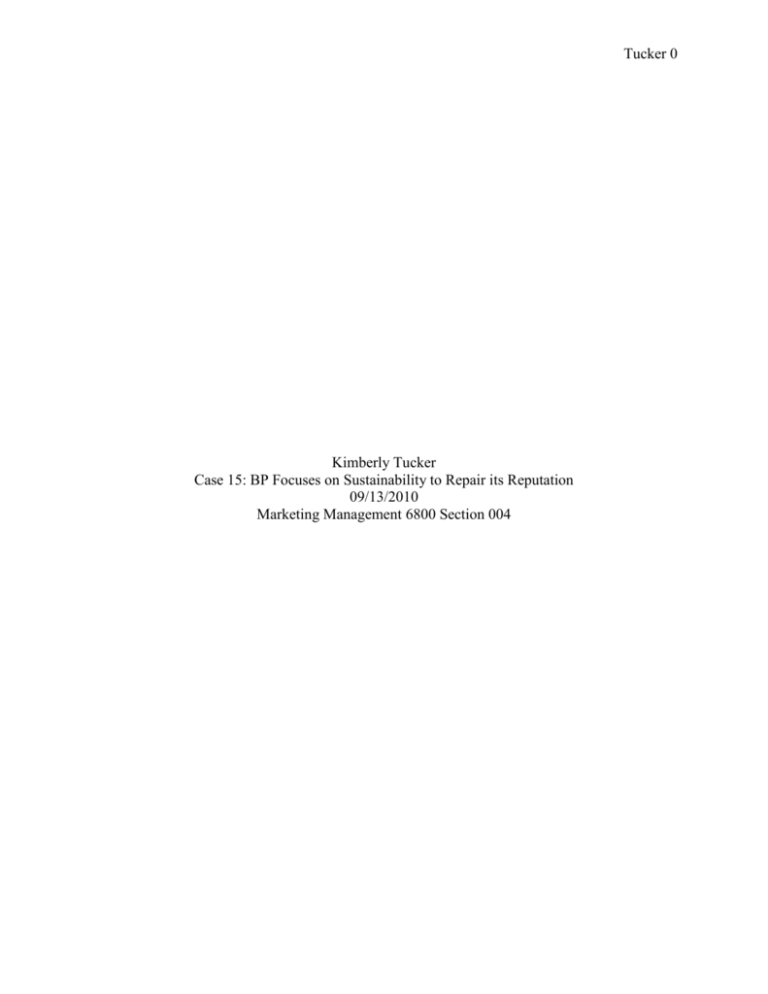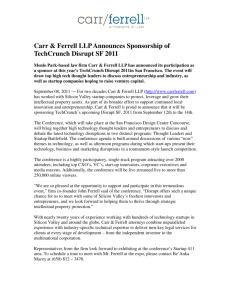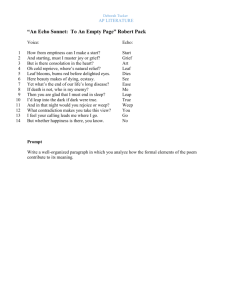Case Study #1 - kimberly doctorial portfolio
advertisement

Tucker 0 Kimberly Tucker Case 15: BP Focuses on Sustainability to Repair its Reputation 09/13/2010 Marketing Management 6800 Section 004 Tucker 1 The Problem: The problem surrounding BP, formerly British Petroleum Oil Company, is that their poor public image and reputation is due to BP losing sight of their social, legal, and environmental obligations. Essentially, by failing to follow correct safety procedures, ignoring numerous warnings and red flags regarding their operations, and violating legal and environmental acts, BP broke its promise to address and care for the concerns of the environment, society, stakeholders, employees, and consumers with “an intense level of focus and commitment” (Ferrell, et. all 551). Issues Relevant to the Problem: BP’s problem of negligence can be divided into several issues that need to be considered: environmental and safety issues, legal issues, and issues related to the size and growth of the oil market. Regarding environmental issues, BP has violated numerous acts and procedures, such as the Clean Air Act and the Clean Water Act, that have resulted in environmental damages. BP is being confronted with safety issues because their failure to heed warnings and red flags produced disastrous outcomes for employees and workers. There are also legal issues surround BP due to a conspiracy “to violate the Commodity Exchange Act and also to commit mail and wire fraud” (Ferrell, et. all 552). Analysis of Issues: Environmental and Safety Issues: Throughout its history, “BP’s actions have not always coincided with its words” (Ferrell, et. all 551). Their professed dedication to the safety of the environment and their workers has been called into question recently because their violation of several environmental acts has been inextricably tied to environmental damages and hazardous working conditions for employees. In 2005, BP’s negligence and failure to adhere to “several procedures required by the Clean Air Act for ensuring mechanical integrity and safe startup” since 1999 resulted in “an explosion at a BP-owned oil refinery in Texas [that] killed 15 employees and injured another 170 people” (Ferrell, et. all 551). In another instance, the U.S. Environmental Protection Agency found BP guilty of discharging “more than twice as much lead and cadmium from its hazardous waste incinerator during a test in March 2004 than is allowed by the Clean Air Act” (http://www.contractormisconduct.org/index.cfm/1,73,221,html?ContractorID=61 &ranking=60). Excessive exposure of BP workers to these hazardous air pollutants were found to cause kidney disease, reproductive disorders, lung damage, and neurological impairments. A year later, BP was again failing to respond to numerous warning signs. Leaks in their Alaskan oil pipelines led BP to be in violation of the Clean Water Act. With thousands of gallons of crude oil spilling onto the fragile tundra and frozen lakes of Alaska’s Northern Slope, many Tucker 2 plants and animals were killed, habitats were destroyed, and the environment was deeply damaged. As demonstrated, BP’s environmental transgressions and violations of environmental acts had a negative impact on more than just the environment. They also affected the safety of and working conditions of BP employees. Legal Issues: BP has also been confronted with serious legal transgressions lately. During 2003 and 2004, “traders working for a subsidiary of BP America Inc. conspired to manipulate and corner the market for TET propane, or propane transported in the Texas Eastern Products Pipeline Company pipeline system to the northeastern and midwestern United States” (http://www.usdoj.gov/opa/pr/2006/June/06_crm_401.html). The conspirators set in motion a strategy in which they would use BP’s “market power and financial resources to buy large quantities” of TET propane, “corner the market by reducing the supply,” and then sell the TET propane to other market participants at “an artificially inflated price” (http://www.usdoj.gov/opa/pr/2006/June/06_crm_401.html). The anticipated outcome of this conspiracy was to enrich BP and the conspirators. This scheme of market manipulation, which was endorsed by BP senior executives, was investigated and BP was soon “charged with conspiring to violate the Commodity Exchange Act and also to commit mail and wire fraud” (Ferrell, et. all 552). As a result, four of the conspirators were indicted and BP was forced to pay millions of dollars in criminal and civil penalties. These criminal acts, these violations of federal laws demonstrate BP’s failure to uphold its promise to respect the wellbeing of the company’s stakeholders. Instead of being a socially and ethically responsible company, BP lost sight of their responsibilities and focused on the bottom line, their profits. Size and Growth of the Oil Market: During the second half of the twentieth century, there were a couple of key factors that affected the oil industry, and in turn, BP. This period “saw enormous growth in the oil industry” as oil fields were being established and rejuvenated in countless countries throughout the world, oil companies were consolidating, and many oil-producing nations set up their own refining operations (Ferrell, et. all 551). Also, the foundation of OPEC (the Organization of Petroleum Exporting Countries) in 1960 led to member countries, including Iran, Iraq, Kuwait, Saudi Arabia, Qatar, and Libya, establishing their influence in the world market (http://www.wtrg.com/prices.htm). During this period there were “massive power shifts in the Middle East” which included a coup in Libya, the nationalization of BP’s share of an oil operation in Libya, and the nationalization of oil operations in other Middle Eastern countries (Ferrell, et. all 551). This affected BP because “oil production in the Middle East fell from 140 million barrels to only 500,000 barrels” and, in order to survive, “BP had to find new sources for oil” (Ferrell, et. Tucker 3 all 551). These new oil fields were located in Scotland and Alaska. Due to the remoteness of the locations, the harsh weather, challenging engineering projects, and many potential environmental risks, BP was unable to “act as a responsible environmental steward” (Ferrell, et. all 551). Viable Alternatives: In order to repair their shattered image, BP has changed its name, focused on renewed efforts in environmental protection and recovery, worked to find new sources of energy, recognized the problem of climate change, and dedicated itself to going green by launching “its Alternative Energy business” (Ferrell, et. all 553). However, there are several other courses of actions the BP oil company can take in order to remedy their problem of failing to uphold their legal, environmental, and social responsibilities. BP’s transgressions have resulted from negligence and failure to follow correct safety procedures, legal acts, and environmental acts. Thus, some potential solutions might include putting BP on a probation period, requiring training for all BP management and employees, and hiring an outside source to monitor BP’s actions relating to safety, legal, and environmental procedures. Analysis of Alternatives: Probation: One solution to BP’s problem of negligence is for the Federal Government to put BP on a probation period. During the time that BP is on probation, they would be responsible for paying fines to compensate for their legal, environmental, and safety transgressions. They would also have to temporarily shut down oil production in the areas that had been subject to BP’s legal and environmental offenses. They would then be required to prove and guarantee that the problems had been corrected: that the pipelines were fit for use, legal and environmental acts were understood and abided by, and new safety measures were implemented before BP could resume full working and oil production capacity. This solution would only be a short-term fix because the probation period would only be temporary and, at its end, BP might not have an incentive to maintain their responsibilities. Yet, during this period, BP would have compensated the appropriate people and agencies for their transgressions and would have already started in the right direction to fixing its problems. Training: Requiring all BP executives and employees to attend training sessions on safety procedures, legal issues, and environmental acts that directly affect BP is another viable solution to BP’s failure to adhere to their obligations. During the sessions and workshops, employees will be tested on legal and environmental acts, safety Tucker 4 procedures, and BP’s HR policies and Code of Conduct. They will also be required to establish a contingency plan for BP’s main problem areas. In the short run, this solution could be somewhat expensive for BP because they would have to hire educated and licensed teachers/trainers, book the facilities for the sessions, and make food, travel, and time arrangements for both the educators and the employees. Unregulated and sporadic training sessions would also not produce the desired outcome of fixing the problem, and if BP fell into financial difficulty, these sessions would be the first to go in order to save money. However, the long term effects would out-weigh the short term. Essentially, this solution focuses on educating all BP employees about their past problems and what they should do in order to avoid the same mistakes. This knowledge will stay with the workers, and make every employee individually responsible for upholding BP’s legal, social, safety, and environmental responsibilities. Monitoring BP’s Actions: A third solution to the problem surrounding BP is for the Federal Government to hire an outside source to monitor BP’s legal, environmental, and safety actions. On a quarterly basis, each of BP’s sites would be subject to inspection by agencies trained and educated in environmental acts and issues, legal issues, and correct safety procedures. While a potential short term affect could be the resentment of BP executives and employees to the governmental agencies; in the long run, knowing that their work would be inspected on a regular basis could motivate employees to stay focused on their responsibilities. Decision: After considering the benefits, strengths, and weaknesses of each viable solution, I think the best option for BP is to implement required training sessions and workshops for every BP executive and employee. This solution, while expensive to implement, will be costefficient in the long run due to the fact that BP will no longer be paying millions of dollars in fines because the training sessions will educate the workforce on correcting and maintaining their legal, environmental, and safety obligations. This solution will also hold every BP employee accountable for their own actions and the actions of the company. Thus, if a mistake is made, it is more likely to be understood and corrected, and those responsible are more likely to be adequately punished. Implementation of Plan: In order for the training sessions and workshops to be a success and produce the desired outcomes for BP, there are several aspects to implementing this plan. First, the training sessions are to be required for every BP executive and employee, on every level of the BP Company. BP executives of the Human Resources Department will be put in charge of hiring the appropriate educated and licensed trainers, making all the necessary Tucker 5 arrangements, and securing all the necessary provisions. In order for these training sessions to occur on a monthly or quarterly basis, an adequate budget will be established just for the legal, environmental, and safety training of BP’s workforce. This budget will be determined based on best practice models and will later be revised after there has been an evaluation of the first wave of training workshops. Within the training sessions, BP executives and employees will be educated on the legal issues, the environmental issues and acts, and the safety procedures that directly affect and impact BP. At the end of this training, the attendees will be tested on their knowledge of these areas, as well as their knowledge of BP’s Code of Conduct and HR Policies. They will also be required to do a risk assessment analysis and develop a mini contingency plan that address possible future problems and violations relating to legal, environmental, and safety issues. Tucker 6 Works Cited Ferrell, O. C., and Michael D. Hartline. Marketing Strategy. 5th ed. Mason, OH: Thomson South-Western Cengage Learning, 2008. Print. "Contractor Profile - Federal Contractor Misconduct Database - POGO." Home – Federal Contractor Misconduct Database - POGO. Fri. 10 Sept. 2010. <http://www.contractormisconduct.org/index.cfm/1,73,221,html?ContractorID=61&ranki ng=60>. "#06-401: 06-28-06 Former BP North America Trader Pleads Guilty to Conspiracy to Manipulate and Corner the Propane Market." Welcome to the United States Department of Justice. Fri. 10 Sept. 2010. <http://www.justice.gov/opa/pr/2006/June/06_crm_401.html>. <http://www.usdoj.gov/opa/pr/2006/June/06_crm_401.html>. The, By. "History and Analysis -Crude Oil Prices." WTRG Economics -OPEC, Crude Oil, Natural Gas, Analysis,forecasts and Data. Fri. 10 Sept. 2010. <http://www.wtrg.com/prices.htm>.







